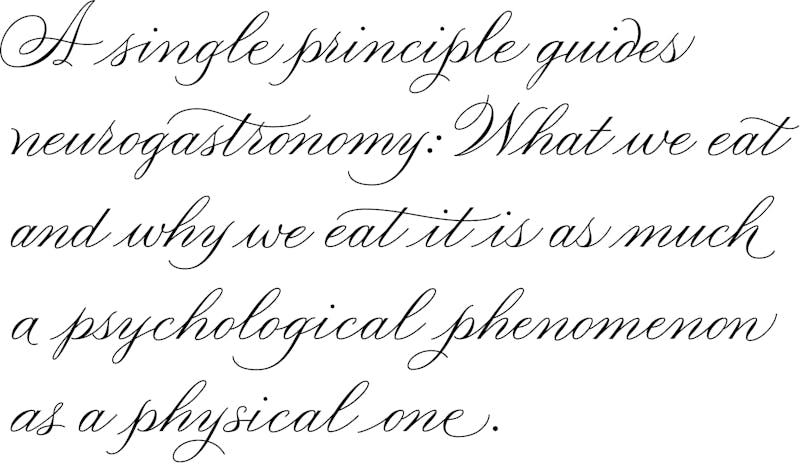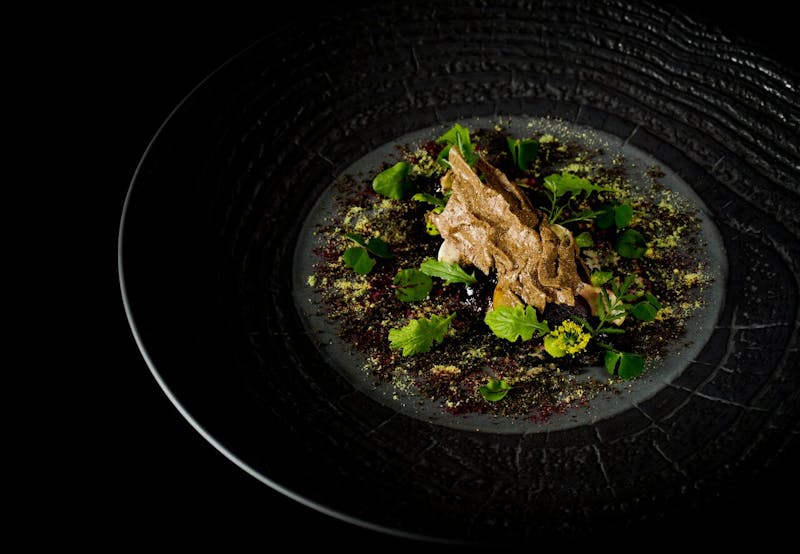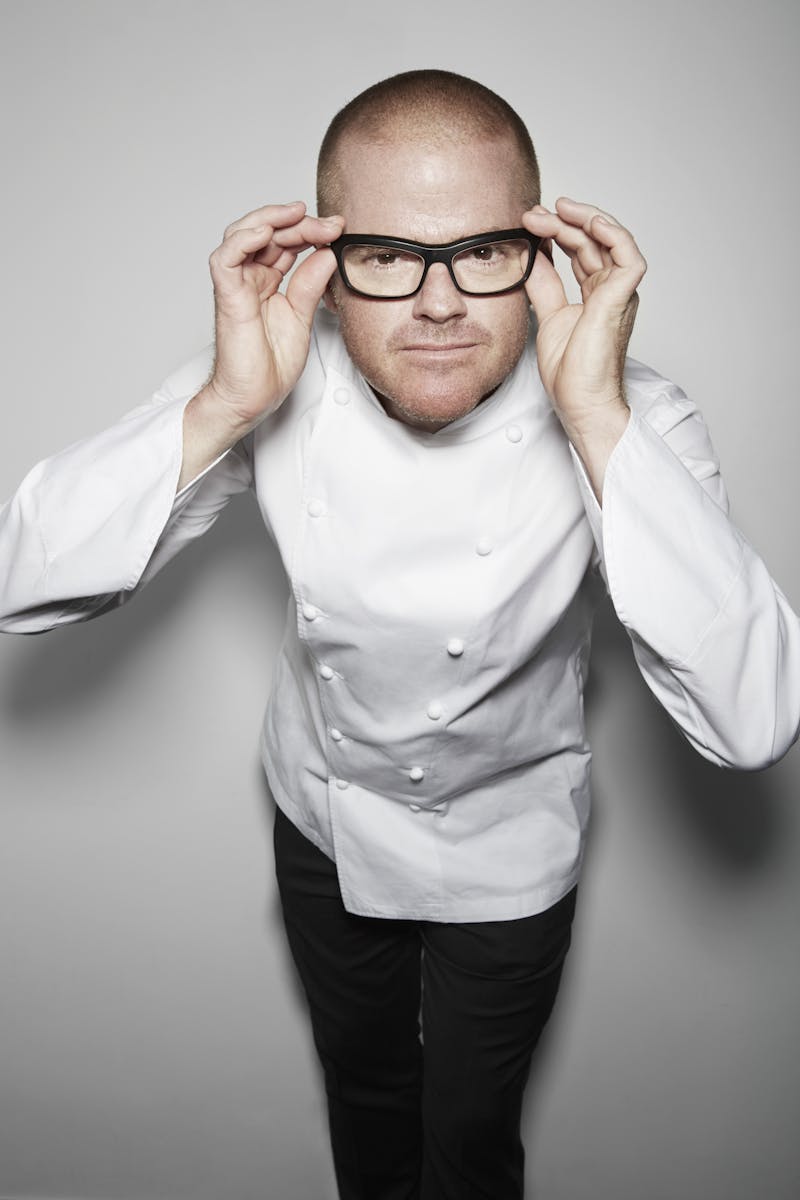The light in the room softly brightened and grew warmer, yellower, somehow more embracing. A quiet rustling—wind through leaves?—reached my ears. A white mist covered the table, carrying with it, somehow, the smell of damp earth after a late summer storm, and the promise of the mushrooms which would bloom in its wake. At the center of my table: a cylindrical terrarium-like enclosure filled with layers of soft green moss, soil, and broken branches, complete with a miniature tree. A plate was silently placed in front of me, or rather, a dark brown platform of what looked at first to be sod (actually a mixture of beetroot and mushroom powder with truffle), adorned with bursts of yellow pollen (a compact butter with truffle, root vegetables, and salt), anchored by a crinkled log (potato-starch paper covered in smoked salt, powdered mushroom, and porcini), punctuated by tiny green leaves (fig leaves), and at the bottom, a thin layer of mushrooms (button, anchored by a mushroom stock jelly). Beneath all this theatricality was an undeniably delicious dish. Even today, I recall its flavor and think of these as the best mushrooms I’ve ever eaten, though, in fact, I’ve consumed ones both more rare and more expensive. A map, which serves as a sort of menu for the Fat Duck, Heston Blumenthal’s three-starred Michelin restaurant in Bray, England—one of only four in the country—described this dish as “damping through the boroughgroves.” Presumably, no mome raths would be consumed.
It was mid-October, and the Fat Duck, one of England’s best-known modernist restaurants, had just reopened after a nine-month hiatus and a $3.6 million redesign and reconceptualization. “It was time for a change,” the 49-year-old Blumenthal told me as we walked the restaurant. Blumenthal—one of the leading chefs in the world, a constant presence on global best-of culinary lists, and the host of several television shows in England—is a towering figure in his chef’s whites and thick, black-framed glasses, equal parts cook, linebacker, and fast-talking salesman. It’s difficult not to get swept up in his exuberance. Of course it was time for a change, and of course the changes were incredible. “We’d been going so fast for so long that we couldn’t keep up with all of these exciting advances happening outside the kitchen. It was time to rethink.” And so, while a pop-up carried on the restaurant’s name in Melbourne, Australia, Blumenthal and his team continued working, only instead of serving customers, they invented new dishes, conducted experiments, and devoted themselves to creating a dining experience on the frontier of gastronomic science, a place where brain, body, and nutrition intersect.
The Fat Duck’s map wasn’t a menu in the traditional sense. It offered few clues to each dish’s contents, and the dishes themselves often appeared to be more Wonderland-like flights of whimsy than actual food. I was treated to Mock Turtle’s soup (complete with the White Rabbit’s gold watch); March Hare’s tea (the “itinerary” included with Blumenthal’s map reads, for this dish: “Excuse me, there seems to be a rabbit in my tea”); and a (literally) floating dessert concoction marked “counting sheep.” Lewis Carroll served as an inspiration, Blumenthal said, a means to stimulate the “fun” and “curiosity” that he feels should be part of any food experience. But the intention behind the food was quite serious. Blumenthal was trying to persuade people to engage with food in a fundamentally new way, one that is both physiological and emotional. “It’s not just about the food,” he said. “It’s the ebb and flow of the story, the look and feel of the room, the temperature, all that.”
The Fat Duck is operated along the principles of neurogastronomy, an emerging scientific field that examines how our sense of taste is interpreted and reinterpreted by the brain. The term itself was coined about a decade ago by Gordon Shepherd, a neurobiologist at Yale, who has been studying the science of olfaction for more than half a century. His research has shown that flavor, a complicated and little-understood concept, does not originate in what we eat, but in what our minds derive from the experience. “Our sensory and motor appreciation of what we have in our mouth is created by the brain,” he said. “We can’t have gastronomy without it.”
This is the overarching principle that guides neurogastronomy: What we eat and why we eat it is as much a psychological phenomenon as a physical one. Throughout most of history, eating has been understood as a primitive human characteristic, an evolutionary necessity, the stuff of base survival instinct. This perception turns out to be far too simplistic. The more we learn about flavor, the more we realize just how easy it is to manipulate. Not just by the overclocked sensations of processed food, but in ways that makes healthier choices seem at once tastier and more satisfying. Though most of us would like to think we have discerning palates, our taste is quite easy to fool.
When we try to imagine the flavor of something, we tend to focus on our mouth—the experience of placing, say, a ripe strawberry on our tongue. But that, in fact, is taste, and though we tend to conflate it with flavor, a vast chasm exists between the two. Taste is an experience composed of only five elements: sweet, salty, bitter, sour, and umami. Thousands of receptors on our tongue are designed to identify and respond to these elements, each one specializing in one of the five qualities. Without input from other senses—most notably our nose, but also our eyes, ears, and even hands—taste is merely a flat, single-note sensation with none of the nuance or enjoyment we associate with food in general and with specific foods in particular. Flavor is at once a broader and more powerful property than taste, one that marries the senses and their associate properties—memory, experience, neurobiology—to create and control the way we eat.
The promise that neurogastronomy holds is that once we understand how the mind combines the disparate biological and evocative forces that create flavor, we will be able to circumvent the learned and innate preferences of our taste buds. And with that capacity—truly an example of mind over matter—instead of stimulating appetite via the conventional and unhealthy trifecta of salt, sugar, and fat, we can employ the neural pathways through which flavor is constructed in the brain to divert attention to different, more nutritious foods. Control flavor and you control what we eat—and perhaps, given time and more research, begin fighting the global nutrition problems that are a direct result of the industrialized production of food.
Our preferences for salt, sugar, and fat evolved within the context of our species’ historical nutritional scarcity. These basic tastes are the echoes of prehistoric signals that saw humanity through epochs of less abundant food sources. They made sense when we were hunter-gatherers eating only what we could kill; less so, when navigating the line at the local Subway. Indeed, our basic physiological response to taste is largely innate. Give an infant something sweet and she will lick it up. If it’s bitter, she will spit it out. (Bitterness signals potential poison.) We learn to like certain complex tastes over time, but our cravings for sweetness and fattiness remain constant. And so, we continue to consume and store reserves for a hard winter that, today, never comes.
Ivan de Araujo, a neuroscientist at Yale Medical School who studies energy and reward in the brain, calls this the great conundrum of humans and food. “Why do we tend to violate homeostasis and equilibrium and eat more food than we need physiologically?” he asked me recently. “Why is there a bias in getting more energy than you’re going to expend?” The genetics of weight gain, psychological traits, and sensory perception of food are informed by these questions. When we attempt to address problems of global nutrition, we fight an uphill battle against the energy-craving and storing machine that is the human body.
These signals, rooted in evolutionary biology, have given rise to a paradox of malnourishment amid a global abundance of food. In many countries, including England and the United States, poor diet now rivals smoking as the greatest public health risk. Malnutrition does not necessarily mean lack of food but, rather, lack of proper nutrients. You can eat five meals a day and qualify as malnourished. (Case in point: Morgan Spurlock’s near-lethal experiment in Supersize Me.) When it comes to certain nutrients, in fact, an estimated 80 to 90 percent of obese individuals are malnourished. (The same percentage holds for non-obese individuals.) Globally, more than 600 million adults and 42 million children under the age of five are obese. Alongside the rise in weight, we’ve seen a corresponding increase in diabetes, heart disease, and a host of other diet-related problems. In the United States, more than a quarter of the population suffers from some form of metabolic syndrome or illness. Nutrition, in many ways, is the great public health battle of our times.
It’s more than just the descent of man, of course. Modern society often perceives of health and flavor as mutually opposed. In England, I met Jozef Youssef, an energetic 34-year-old chef who splits time between research collaborations with psychologists and running Kitchen Theory, a London pop-up restaurant where he tests various scientific findings on small groups of diners—including ways to make “healthy” and “tasty” seem complementary rather than antagonistic. Youssef cited the example of a green smoothie. “We see it and we think, it’s good for you but it’s probably not enjoyable,” he said. “Why is that?” (This also works the opposite way lately, as people have been questioning exactly how healthy the overpriced green smoothies are at Whole Foods.) A study published this year in the Journal of the Association for Consumer Research found that people tend to feel less full and eat more after consuming a food they perceive as “healthy,” even if it’s identical to one that is marked as unhealthy. For example, they will feel hungrier after a “healthy” cookie—and go on to eat more overall.
In this way, evolution and socialization are locked in unending conflict, nature and nurture conspiring to produce ever-increasing consumption of less-than-ideal foods. And indeed, past efforts to replace the salt-sugar-fat trifecta with healthier equivalents haven’t been successful. Think margarine instead of butter, saccharin replacing sugar, artificial polymers (macromolecules synthetically created in a lab) replacing the fat content of milk or ice cream. It’s your low-fat frozen yogurt, diet soda, the 100-calorie snack pack. The results, from a flavor perspective as well as a dietary one, have been underwhelming. Instead of curbing obesity and metabolic disorders, these innovations seem to have resulted in the opposite. This may, of course, be correlation rather than causation, but still—and perhaps worse—some of the substitute substances haven’t proven to be as healthful as first suggested. Companies scrambled to scrub margarine from their recipes after research showed that it was actually more harmful than the butter it replaced, while recent work from people like Dana Small, a neuropsychologist and physiologist at Yale, highlights the metabolically disruptive effects of artificial sweeteners, even ones derived from natural substances, like Splenda.

What’s more, many (most? all?) low-fat and low-sugar products don’t taste good, aren’t eaten as often as their sinful counterparts, and end up a bust both nutritionally to the customer and financially to the producer. And the consumption of the real thing keeps rising. Sugar was first introduced to the Western palate via New Guinea about 10,000 years ago. By 1800, Americans were consuming an average of seven pounds of the powder a year. Today, our consumption tops over 100 pounds. (By way of comparison, we eat about 50 pounds of beef.) Though we are drinking less soda than before—2012 production was 23 percent lower than a decade prior—people are still taking in 30 gallons of regular soda per person each year, according to New York University professor and public health advocate Marion Nestle. And things like diet soda seem to have a reverse psychological effect: New research suggests that tricking your brain into thinking it has consumed calories when it hasn’t can, over time, have a host of negative metabolic consequences, as the connection between the energy signal of sweetness and its actual energy content decouples. And so, you consume more, and even worse, you want to keep consuming more (the dreaded sweet tooth).
Why should neurogastronomy be different? Why would it succeed where basic physiological nutrition has failed? Part of the answer stems from the insight research has given into how, exactly, our bodies derive energy and flavor signals from food via the brain. It’s not about calories—that is, eliminating calories in the manner of artificial sweeteners likely won’t work. Instead, it’s a far more complex process of taste perception. It’s a growing understanding that psychology plays a more central role in the experience of eating than previously thought, a realization that we need to be fooling the brain, not the body.
In 1936, H. C. Moir, an analytic chemist from Scotland, who had worked at a baked-goods factory, presented what may be the earliest findings that show just how much our brain affects taste. He had people eat incongruously colored jellies—green-colored orange, red-colored lemon, and the like. He then had them taste chocolate-colored sponge cake, one of which was imbued with cocoa and the other with vanilla. Only one person was able to correctly identify each taste in the two tests—and over half got more than 50 percent of the answers wrong. Some of the answers given for the orange candy: almond, strawberry, black currant, and pineapple. For lemon: cherry, raspberry, strawberry, damson. Some tasters thought the chocolate biscuit was vanilla, and the vanilla, chocolate, while others volunteered coffee, orange, or even unflavored.
“The majority of those who came below 50 percent went to great pains to assure me that they were considered by their wives or mothers, or other intimates, to be unduly fastidious about their food, and were invariably able to spot milk turning well in advance of any other member of the household,” Moir wrote. “Consequently, it was obvious that the method of testing was at fault, and not the palate being tested. Further, many brought in a plea of individual idiosyncrasy in that they did not like table jellies etc., but comparatively few made this plea before the test.”

When it comes to the caloric content of food, our brains aren’t easily fooled. You can, it turns out, engineer all the low-fat polymers and artificial sweeteners you want, but they will likely not make us eat fewer calories or gain less weight: Our brain is too smart for that. In one study, de Araujo genetically engineered a group of mice so that they would no longer taste sweetness. The receptors that signal “sweet” to the brain simply didn’t function. He found that though they started off indifferent to sugar, the mice soon learned that when they were hungry, it was better to consume a solution with sugar rather than one that was all water. They had no way to distinguish the two from a sensory perspective—taste-wise, to them, they were identical—but somehow, their brains learned where the energy source lay. Soon, the rodents were consuming just as much sugar as non-modified animals. The effect was completely absent with artificial sweeteners. In another study, de Araujo followed up with a group of regular mice. This time, the mice were offered two sweet solutions, one with sugar, and one with artificial sweetener. The solution with the sweetener tasted sweeter—and so, one would think the more attractive of the two. And indeed, for the first day, the mice consistently drank the sweeter water. But then something happened: They began to ignore the artificial sweetener and instead focused exclusively on the real sugar solution. “Somehow the brain knows when something is purely sweet and good-tasting versus when that good taste comes along with energy,” de Araujo said. In other words, we have two separate systems that signal the value of food. It’s not just about taste; it’s about how taste is incorporated into our brain’s reward system. And artificial substitutes—ways of lowering calories while keeping their sensory qualities—simply do not work. The brain isn’t fooled. It knows real calories from the taste of calories.
Research like de Araujo’s doesn’t just show us what won’t work: It suggests what might work instead. The deeper understanding of sensory integrations gives an alternative approach to making nutritional changes to the diet: Alter rather than substitute. Use real sugar, real energy, real fats and salts and the whole gamut of flavor, but do so in lower quantities, in a way that makes the result taste good and sends actual energy signals to the brain, creating an experience that is both psychologically and physically satisfying.
On my wander through the boroughgroves at the Fat Duck, my dish wasn’t just a plate of food. It came with an abundance of theatrical effects, all of which served specific functions: My hearing was engaged—the crackle of the ground and rustle of leaves. My vision—not just the beauty of the plate but the forest mist, the mini-terrarium, the variegated effects of the lighting. (“Unique to each table,” Blumenthal pointed out. Each diner’s lighting is calibrated depending on where she finds herself on her journey at any given point.) My smell—both when I first inhale the earthiness (via orthonasal smell, or what we typically think of as smell) and after I put the first bite of the powdered-mushroom log into my mouth and exhale (by way of retronasal smell, or, as Shepherd explained, “the smell that comes internally, from behind, from our mouths into our nasal cavities”). My touch—the texture of the smooth mushroom, contrasting with the roughness of the faux bark, the crispness of the greens, the creaminess of the truffle butter. Even something I don’t usually think of as a sense—my memory—combined to put me in mind of memories of family walks through the woods. The idea is that due to the multisensory pleasure of the experience, not only will I enjoy the dish more, but I will feel more satiated after having eaten less. “When you first see it you think this guy’s taking the piss,” said Francis McGlone, head of the Somatosensory and Affective Neuroscience group at Liverpool John Moores University, and until recently, head of the food neuroscience research group at Unilever. “There’s nothing on the plate but these small portions. But you won’t leave the restaurant hungry. Because there’s so much complexity, in terms of textures, colors, tastes; it’s almost symphonic. You reach satiety faster.”
Fast food is so addictive because salt, sugar, and fat never appear together in nature. Try to imagine a naturally occurring food that is fatty, has high amounts of sugar, and is salty to boot and you’ll come up short. And so, strongly reinforcing neural pathways that were only ever meant to fire in isolation, to tell us that a food is worth eating, now activate all at once, creating an enticing, addictive cascade that is greater than the sum of its parts. In a sense, Blumenthal’s approach is doing the same thing—only using complex psychological flavor rather than purely physiological taste reinforcement.

One basic approach to this focuses on actual changes to the composition of food—ways of cooking different substances that makes them taste sweeter, saltier, or spicier than they actually are. A favorite of Blumenthal’s, which he has used successfully in the Fat Duck for more than a decade, is a method called encapsulation, in which he presents a flavor in a way that makes it seem far larger than it is. “If you think of a cup of coffee made with one ground bean, that would be really insipid,” Blumenthal suggested. But if you crunch a bean in your mouth, you suddenly have a much stronger coffee flavor, even if the cup itself is quite weak. A single whole bean can deliver a greater flavor punch than multiple beans that have been ground and brewed. The same thing happens with a spice, like coriander. Add a few seeds to a dish rather than grinding them, and suddenly, the flavor becomes much more intense even though the overall quantity of coriander goes down. “Every so often, your mouth crunches one, and there is an explosion of flavor that makes it much more interesting,” Blumenthal said.
With an encapsulation approach—a few strong bursts rather than dispersed flavor—Blumenthal has successfully reduced the salt content of multiple dishes in his restaurants. The final taste experience is just as salty overall, even though the amount of sodium has been reduced. It’s a method that one could see playing out in mass-produced items, including your beloved Doritos, fast-food fries, snack bars, cereals, even packaged meals that rely on large doses of sodium to deliver post-frozen taste. “You have fewer, larger grains of salt, and suddenly, you can deliver the same flavor, but with less,” Blumenthal told me.
Barry Green, formerly at the Monell Chemical Senses Center in Philadelphia and now at Yale, accomplishes something similar through heat. A psychophysicist—someone who studies how physical sensations get interpreted by the brain—Green has worked on the way the thermal sensitivity of the mouth, that is, our perception of hot and cold, can affect a food’s flavor. Temperature, and specifically, temperature change, can influence how sweet we think something is. Fifteen years ago, while Green was working at Monell, a University of Michigan study found that some of the taste fibers (specialized nerve cells) in the chorda tympani nerve, one of the three cranial nerves responsible for sending taste sensations to the brain, were sensitive to temperature. The nerves responded to warm liquids much as they did to sweetness—even when there was no sugar present.

In a later study, Green called this phenomenon “thermal taste”: temperature that evokes a flavor. We have fibers that get excited when we warm them up, which might make a food or liquid taste sweeter than its sugar content warrants. One way to think about it is to picture yourself licking an ice-cream cone. The initial cold taste isn’t nearly as sweet as the flavor of the warmed ice cream once it’s back in your mouth. That finding has immediate implications for a multitude of foods. One easy way to get a sweet kick: Take sodas, juices, fruit, and whatever else out of the refrigerator.
One of Blumenthal’s signature dishes at the Fat Duck is a rabbit “tea”—actually a velouté of rabbit—that is both hot and cold. A specially engineered gel keeps the two sides separate until poured. The result is disorienting: Your tongue is hot and cold at the same time. The flavor is intense, the pleasure, surprising—and the relatively lower levels of seasoning needed to deliver a flavorful experience perhaps most surprising of all.
While it’s difficult to imagine the packaged food equivalent of dual-temperature tea, the same effect, Green pointed out, can be attained by warming something that is cold or by cooling the tongue itself so that the same food tastes relatively warmer. Two things happen physiologically when the sensation of either warming or cooling hits the tongue. In the first case, sweetness increases, while in the second, the perception of saltiness becomes more intense. In 2010, Campbell’s Soup had something of a PR disaster when it announced that it had lowered the sodium content of its soups. Customers protested that the reformulated versions didn’t taste as good, and sales fell. Yet imagine the exact same reformulation, but with the introduction of, say, a chilled soup like gazpacho. The cooling would create an enhanced salty flavor, and the soup might replace less healthful alternatives. Knowing some of the thermal principles involved in flavor perception may enable Campbell’s to create tweaks not just there, but to its hot soups, in ways that reduce sugar and salt but enhance flavor.
Another, potentially broader area of experimentation comes from olfaction. Our brains form associations between smells and tastes that, in turn, affect both how much we like a certain food and our bodies’ anticipated response to it (how our brain prepares the rest of the system for the calories it thinks it’s going to consume). Those associations can then be used to trigger the reward system even when the perceived reward is smaller than the actual one. Take vanilla. Vanilla isn’t actually sweet. It’s quite bitter. But in the Western world, we have come to associate it with sweet foods, and so, to us, it signals sweetness. When we smell it, our sweet receptors go on high alert—and the food we eat tastes sweeter than it otherwise would.
I have to imagine that some of the pungency and sheer fungal intensity of my mushroom dish comes from the olfactory tricks that punctuated it. The fog that spread over the table wasn’t just visual: It spread the scent of the moss. Throughout the meal, I could tell without looking when another table had gotten to this particular point in the dinner. The scent heralded its arrival better than anything else could. The mushroom powder on the plate further reinforced and carried the scent, so that by the time I took a bite, all my taste buds were primed for the resulting flavor. A few weeks later, Blumenthal told me he still wasn’t completely happy with the dish. “We’re still working on creating the perfect smell of the woods,” he said.
Part of my pleasure from the mushroom dish doubtless derived from the childhood associations I carry with its taste—mushroom picking with my grandfather, cooking up big skillets of freshly gathered mushrooms and onions in the early fall with the whole family. (We’re Russians, after all.) But to someone for whom that affinity is absent, or even reversed, the techniques could have detracted from rather than enhanced the experience, by concentrating the flavor so intensely. Likewise, to a non-Western palate, even something that seems as straightforward as Blumenthal’s proposed vanilla addition might backfire. Some Japanese pickled foods contain an almond-like aroma, for example, while sweet almond desserts are mostly absent. The implication here is that taste-smell associations—and the resulting preferences in food—can be changed from experience. Yes, some taste is innate, but the way we perceive it psychologically is a learned process, one that starts in the womb. In one study, newborns whose mothers had eaten food with anise during pregnancy enjoyed its scent more than those with mothers who had not. Children of mothers who drank milk flavored with carrots while pregnant were more likely to eat carrots. Adults, unlike children, are far better positioned to make mindful food choices. The fact that associations between basic tastes and non-basic smells develop so early could become a powerful way to subtly change preferences along more nutritious lines.

In the 1970s, UCLA psychologist Eric Holman discovered that certain sweetened substances could make rodents prefer certain foods by virtue of their presence. For instance, by adding a saccharin to either a banana- or almond-flavored solution, he was able to make rats prefer the taste of bananas or almonds, respectively, a process known as “flavor nutrient conditioning.” In recent years, that work has been picked up with humans. Maltodextrin, a glucose polymer, is imperceptible to most of us. It doesn’t taste sweet. In fact, it doesn’t taste like anything. For it to activate the sweet receptors in the brain, the body must first break it down into glucose. If we mix it into another food, we don’t realize there’s a sugar present, but we still develop a preference for that flavor. In one study, people who tasted foods with maltodextrin mixed in would reliably choose the flavor that had been associated with the polymer in subsequent tests. They had been trained to prefer one food over another by a sort of sensory trickery. Imagine dusting a child’s broccoli florets with maltodextrin and transforming a disliked vegetable into a favorite. Ethically questionable, yes. But also potentially quite effective at nudging children toward healthier choices at a sensitive period in life when many such choices are first formed. The end result would be a society that makes better, more nutritious choices without seeing them as a necessary evil or sensory trade-off. Broccoli would be a preferred taste, a food you choose because you’ve learned to enjoy it and find it inherently rewarding. When you went to reach for a snack, a broccoli crisp would be just as, if not more, enticing as a potato chip. “If we can find out how to do that on a large scale,” de Araujo told me, “we could completely change diet.”
The sneaky additive approach, though, is not one favored by chefs like Blumenthal. “We have enough naturally occurring flavors that we don’t do enough to exploit,” he told me. “Like MSG. It’s an old wives’ tale that it’s bad for you. It occurs naturally all the time. Tomatoes. Parmesan. Shiitake. Seaweed.” We can use natural properties to create flavor profiles that are apparent—and make other foods enjoyable by sheer association. It’s an approach that stems from stimulating other tastes that may then make a food more pleasurable by proxy. In addition to studying heat, Barry Green has worked with flavors that could have a similar effect, namely, menthol and capsaicin. The former gives the sensation of cooling your tongue. The latter, found in peppers, warms it up. In so doing, it stimulates the pain system—but in a way that can be pleasurable. Could the addition of foods that work on different neural channels from sweetness and saltiness but that stimulate the somatosensory system just as strongly help reduce the need for things like sugar and salt? “Obviously, chili pepper has become a huge part of the American diet,” Green said. “I’d love to see how that channel of input could be utilized to increase flavor when you’re decreasing things like salt and sweetness … using spice so you don’t have to have a chip that’s as salty, for instance.”
In Blumenthal’s kitchen, such approaches are evident in dishes like the Mock Turtle’s soup from the Mad Hatter’s tea party. A faux-gold watch made from gold leaf covering the equivalent of a beef and oxtail bouillon cube is placed into a teapot of water, only to dissolve into beef and oxtail stock, which is then poured over an “egg” that is actually made of rutabaga and turnip, and also flavored with mustard seeds and pickled cucumbers. The combination of spice, from both the mustard and the pickling, make the oft-ignored tubers—not many people crave rutabaga—shine in a new light, with a complexity of flavor not associated with the uniform blandness of root vegetables. “We really undervalue spice,” Blumenthal said. “But used the right way, it’s eye-opening.”
The wine in the Fat Duck’s second-floor wine cave is hidden behind a faux bookshelf. The bottles are accessible only if you know the proper title to tip off the shelves—part of the ethos of playful curiosity and discovery that permeates the whole restaurant. On the day I visited, the room was empty but for a small round table in the center. It was covered with a white tablecloth and several identical-looking glasses of wine, some white, some red. Blumenthal was running several experiments based in part on the research of Oxford psychologist Charles Spence, the first of which involved the links between dexterity and taste. Isa Bal, the Fat Duck’s sommelier, a dapper-looking man in a dark suit, instructed me to pick up a glass of white wine and take a sip.
“What does it taste like?” he asked.
“Smooth,” I replied. “A bit buttery?”
“Now pick it up with your left hand.” (I’m right-handed.)
I drank again, and it was like a different wine: sharper, crisper, more acidic. One explanation for this lies in the neural wiring of the dominant versus secondary hand. Our dominant hand is more fluent, which means the signals from it are processed more easily. If the results were strong enough, one might expect future dinners at the Fat Duck to include non-traditionally placed glass and silverware—and wait staff who instruct guests on the proper hand with which to try a certain dish or drink. It’s not a stretch to imagine such instructions appearing on food packaging: Tear open with your right hand and dig in with your left for maximal pop—or make sure to hold with your right hand for the fullest buttery feel.

Next, Isa played a series of musical tracks and had me taste wine against different songs. And indeed, with each track the taste changed. Alongside one, the white was greener, more effervescent. Along another, smoother. The music played in the Fat Duck’s dining room has been carefully chosen to match the sensory characteristics each dish is meant to convey. The “Sound of the Sea”—an ethereal plate of mackerel, octopus, and king fish covered in a rich seaweed foam and arrayed on a sand-strewn beach (the sand is made from tapioca and miso oil)—was presented with headphones that snaked their way out of a conch shell. An iPod was hidden inside, playing a collection of surf, waves, seagulls, and beach sounds.
Did the music add anything, or was it more theater in an already theatrical meal? In a series of studies to test that, Blumenthal and several collaborators had Ph.D. students eat a similar dish, listening to either barnyard or seashore sounds. They rated their enjoyment levels up to 90 percent higher with the sea soundtrack. I got another taste, so to speak, of the same phenomenon when I took part in some of the ongoing studies at Spence’s cross-modal laboratory at Oxford. A candy bar tasted sweeter alongside a piano; a jelly, more sour alongside brass. “Music changes the sensory and hedonic experience,” Janice Wang, Spence’s graduate student in charge of the experiment, explained. “The olfactory nerve is partly connected to the auditory—and the more we learn about how the senses are wired, the more we can change the experience by changing the auditory environment.”
A little more than a year ago, the Cadbury chocolate company changed the shape of one of its bars from rectangular to round. “People complained about it being sweeter,” Spence said. This was, in one sense, a marketing error—but it was also a missed opportunity. Could Cadbury’s not have reduced sugar at the same time, thereby rendering the reduction imperceptible, and thus creating a healthier candy bar? “Reducing the ingredient by some amount and changing packaging to make it neutral in the consumer’s perception is a very real goal,” Spence said. Other studies show that heavier cutlery or packaging makes a food taste better, that certain colors and contrasts can make it taste sweeter, saltier, smoother, more bitter, more sour, even that the language we use to describe it can make a difference in how it’s perceived. One can easily imagine that part of the appeal of Mast Brothers chocolate was in the packaging: What they lacked in flavor they more than made up for in artisanal-seeming wrapping. Perhaps this was also one of the reasons the blowback against them was so harsh. People felt deceived, as, in a sense, they were.
No matter how much we learn about neurogastronomy, though, a disconnect between what’s possible and what can actually be accomplished will doubtless remain. Not everyone will be happy that the sugar content of their chocolate bar has been lowered. “Innovation is really slow in food companies. It’s really difficult to get things done,” Spence told me.

About ten years ago, Francis McGlone attempted to bring Blumenthal into Unilever, a leader in the world of FMCG, or fast-moving consumer goods, as a consultant. He felt the company would benefit immensely from the chef’s creativity. The collaboration went nowhere. “No one could agree who controlled the intellectual property,” McGlone said. “They wanted to nail him down to contain his creativity in ways he couldn’t accept. It was a missed opportunity.” He paused. “It’s very difficult to change the way these large companies go about what they do.” Theoretically, they may be intrigued by Blumenthal’s innovations, by his use of the latest science to craft ways to eat more healthfully. But practically, they are beholden to their shareholders. The tolerance for risk and acceptance of failure that marks the Fat Duck’s experimentations—new dishes are the result of many spectacular mishaps in the test kitchen—are unacceptable from their perspective.
And yet the mandate from consumers seems to be changing in a way that may force large corporations to rethink their approach. Companies respond to consumer pressure. What matters is what people want as expressed by what they will buy. Food manufacturers aren’t our parents, nor are they our doctors. They care about profit, not health. But their profit is dependent on shifting preferences and demands. The mass production of the 1960s and 1970s was about the demand for convenience, freeing the housewife from the slavery of cooking. And from that demand came the packaged foods and snacks that fill grocery stores today. But increasingly, consumers are demanding more than simple convenience. They want health, too. Doug Rauch, the former president of Trader Joe’s, just opened a new store, Daily Table, that he hopes will grow from a single location in Boston to a national chain of supermarkets. It aims to sell nutritious food at the price point of fast food. Bananas for 29 cents per pound. A dozen eggs for 99 cents. PepsiCo has just announced a new vending machine initiative, to be rolled out to several thousand locations in 2016, which will offer healthier snack options than the traditional soda and chips—Naked Juice, Quaker bars, Sabra hummus cups, and the like. And interest in the frontiers of nutrition science has risen apace. “People don’t do anything until somebody else does it, then they all want to do it,” Spence said with a laugh. “I had three companies on the phone today. It’s been an explosive growth in interest. And my colleagues working in this space would say the same.”
One initiative, with the University of Barcelona and the Alícia Foundation, a research center helmed by Ferran Adria, the chef of the now-closed El Bulli restaurant, focuses on improving nutrition and recovery for children with cancer. Most common treatments, including chemotherapy, create an eating experience in which food takes on a metallic, ungainly taste. Unlike adults, who can override such unpleasant inputs with the knowledge that they have to eat to get better, children will often refuse food altogether rather than consume something they don’t like. This team of chefs and scientists hope to use the new understanding of the brain’s sensory integration of taste to create foods that would override that aversion, either by changing the perception of the taste or its seeming desirability. “The evidence that we can improve consumption is quite good,” Spence, who consulted on the project, told me. “And a lot of hospitals and end-of-life care are now engaged in sensory design related to food. It’s an important investment.”

Blumenthal told me of a recent project he collaborated on with the National Health Service at the Royal Berkshire Hospital to improve nutrition among the elderly. As we age, our sense of smell dampens—loss of smell sensitivity is one of the earliest signs of dementia—and our desire for healthier foods, along with it. There’s a reason your grandmother douses everything in salt and prefers simple, strong fat-sugar-salt combinations. But something else rises with age: the risk of cardiovascular disease. And so, ways of enhancing flavor that don’t necessitate huge quantities of condiments and fats could go a long way toward easing the aging transition. “We wanted to get the elderly excited about food again,” Blumenthal said. “And I’m hopeful that it can be done well.”
Chefs like Blumenthal are an important first step in the advancement of neurogastronomy. But to realize the full health and nutritional potential of this science, we will need to go much further than test kitchens and high-end dining rooms. Neurogastronomy must be incorporated into mainstream consumption. “It’s like Formula 1 racing,” McGlone said. “The car is the pinnacle of advanced technology. The efficiency and safety of these engines are at the most advanced. But in three, four years, it appears in the average car.” The same could be said of neurogastronomical innovation. “It will ultimately become part of the standard. It will be an advanced use of the technology that will ultimately trickle down into the standard food product.” The fact that why we eat what we eat originates in the mind rather than the palate is a powerful one. Properly harnessed, it could prove to be the key to succeeding where so many other nutritional interventions have failed.